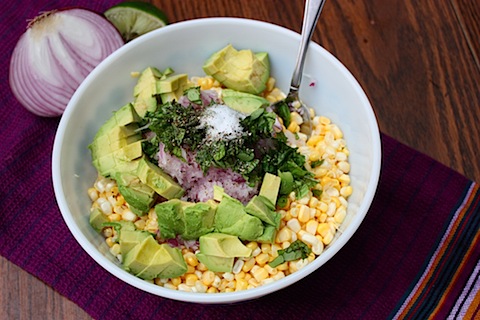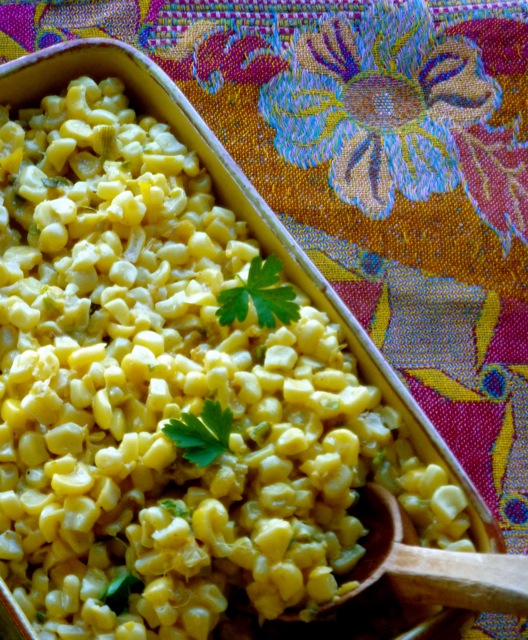From the point of view of a kitchen green bin, corn is the ultimate vegetable. The cobs, the husks, the silk—this is the stuff compost dreams are made of. From the point of view of a transplanted Midwesterner, corn is more problematic. The perfect ear is now elusive and after some research, I am beginning to see why. Growing up in Wisconsin, one of the premier corn-growing states, we looked forward to corn on the cob every summer. About mid-August, when the crickets started chirping we could visit our local sweet corn stand in Mequon and buy our daily dozen ears bagged in brown paper, ready to consume that evening. We preferred small-kerneled cobs, crisp and creamy pale yellow, with a subtle, sweet flavor and a delicate crunch when husked and boiled a few short minutes.
 |
| A typical sweet corn farm stand in the Midwest |
Things changed when I got to Berkeley. Hot, sultry August nights were a thing of he past, and so was sweet corn. Along with the fog came tough big ears of mealy feed-variety fodder. How disappointing! Summer tomatoes, too, were not what I was anticipating. What I gained in luscious apricots and fabulous artichokes, I lost in sweet corn and tomatoes. Every region has its virtues, and that was that, until about the early nineties. In the newly emerging farmers' markets a plethora of sweet corn was available. I tried it from a number of sources and to my surprise, it was really sweet. At first, I was delighted. I enjoyed the transformed summer ears and didn't question the change in bionomics. I discovered a terrific new method of steaming my vegetable in the microwave, no husking required, and all was well. Soon after, I began realizing that this corn on the cob was actually a new product. What had been savory, tough and yellow was now white, overly sweet, chewy, and less complex. Corn on the cob appeared by the fourth of July instead of mid-August, and furthermore, it retained its sweetness for many days, rather than a few hours. We had gone from one extreme to the other. I started to wonder what was involved in all these changes
 |
| Berkeley's Monterey Market has corn from Brentwood, some of the best around |
A little research revealed some interesting answers. According to an article on corn in
The University of Illinois Extension Newsletter, there are three distinct types of sweet corn, each with its own genetic background. The first,
Standard Sweet (or "normal sugary"), is the sweet corn we ate years ago in Wisconsin. Varieties like Silver Queen or Golden flourished throughout the Midwest and the East. They are best suited to being husked and eaten in a very short time. This type has "delicate flavor, tender kernels and slender elegant ears." Over the years new hybrids were developed to increase the sweetness and keep corn fresher for longer. This brings us to the second type, called
Sugary Enhancer. The sugar content is significantly higher in this type, while retaining the tenderness and creamy texture of standard varieties. The taste, texture, and tenderness are outstanding. Then, there is a third hybrid called
Supersweet. This variety has overrun the markets, and to me, has a discordantly saccharin flavor and overly large and crunchy kernels. The Newsletter cited above states, "The kernels of the extra-sweet varieties have a crispy, tough-skinned texture and contain low amounts of polysaccharides that impart the creamy texture and 'corny' flavor to other varieties." Sometimes the Sugary Enhanced and Supersweet are combined in a bi-color variety called Synergy.
U. of Illinois Extension-Corn
 |
| Two summer pleasures— Sweet Corn at the market and The San Francisco Giants ( Way to go Schmidt Farm) |
 |
| Bi-Color Corn at Ferry Plaza Market, combining Sugary Enhanced and Supersweet varieties, according to the vendor |
The trend toward sweeter and sweeter produce is troubling, not only because I don't like it, but also because it encourages the public's expectations that vegetables and fruits must be super sweet to be good. I hear the word "candy" bandied about at farmers' markets lately when customers are praising a piece of fruit. It seems inevitable that we will exchange flavor and complexity for sweetness and durability. America's sweet tooth is insatiable and we are beginning to pay the price.
A positive aspect of the new supersweet varieties is that you can now eat raw sweet corn in salads and side dishes which, to paraphrase Hamlet, was never dreamt of in our philosophy. Raw corn salads proliferate on the Internet and in cookbooks. Below is an especially appealing example, courtesy of Brittany Mullins, author of the lively blog Eating Bird Food.
 |
| Raw corn salad with avocado, red onion and basil—photo courtesy of Eating Bird Food |
 |
| A chef's knife is the best tool for removing kernels from the cob |
I found out just how indestructible the "supersweet' variety really is when I made a favorite corn and coconut dish from the Indian state of Gujarat. The corn kernels are first simmered in milk until the liquid is reduced, before spices and other ingredients are added. This time I started with too much milk and had to reduce it even longer, which took over an hour. I was curious to see how the kernels had fared. I tasted a few and, to my astonishment, they were as crisp and tough as they had been before being cooked! This had to be the Supersweet variety (it is impossible to tell which variety you are buying until you taste it). The hour-long simmering had not affected the texture of the kernels at all.
 |
| Gujarati style creamed corn with coconut milk and spices |
GUJARATI -STYLE CORN COOKED IN MILK WITH CHILES AND SPICES
Kernels from 6 ears fresh corn (preferably Standard Sweet), about 3 cups
1 cup milk
1 t. each ground cumin, coriander and curry powder
1 T butter
2 jalapeno chiles, seeded and chopped
1/2 inch piece ginger, peeled and finely chopped
1/2 cup coconut milk
6 sprigs fresh cilantro, chopped
1. Put corn and milk into a medium saucepan and simmer over medium heat, stirring often, until milk has reduced by three-quarters, 45 min-1 hour. Season to taste with salt.
2. Heat butter in a medium skillet over medium heat, add chiles, ginger and spices and stir for a few minutes until fragrant. Add corn mixture and coconut milk, and mix well. Add cilantro and cook for 1 minute more. Adjust seasonings.
 |
| My faithful, furry friend |
FEATURED BOOK: David Tanis,
Corn: A Country Garden Cookbook, Collins Publishers, 1995
David Tanis, chef at Chez Panisse, author of recent bestsellers
A Platter of Figs and
Heart of the Artichoke, current City Kitchen columnist for
The New York Times, wrote this gem in 1995 as part of Harper Collins Country Garden series. In each volume of the series, a different author covers a fruit or veg and includes useful info, lovely color photos, and elegant recipes. Interestingly enough, in the introduction to this book, written eighteen years ago, Tanis cites the three sweet corn hybrids— Standard Sweet, Sugary Enhanced and Supersweet— discussed above. He too laments the introduction of the extra sweet varieties into the marketplace. He reiterates "For me, some are just too sweet. I'm not convinced that altering sugar genes has produced a superior product, even though it has resulted in improved shelf life."






























